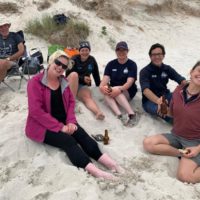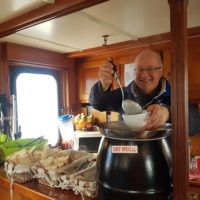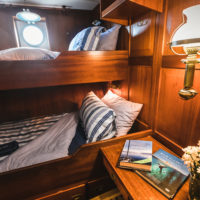BC030724 Sailing Skye and the Small Isles £2025
UK and Scotland

Mallaig, Scotland - Mallaig, Scotland
Explore the rugged scenery and hidden gems of the Inner Hebrides archipelago and Argyll on our tall ship Blue Clipper.
To enquire about this voyage please click the ‘BOOK NOW’ button below and you will be re-directed to our booking agent VentureSail Holidays where you can make an enquiry. VentureSail manage all our holiday voyages and the team at the office are available on 01872 487288 if you have any questions.
| Ship | Per Person Twin En-Suite |
|---|---|
| Blue Clipper | £2,025.02 |
| Embarkation | Disembarkation | Nights |
|---|---|---|
| July 3, 2024 | July 9, 2024 | 6 |
BC030724 Hebridean Explorer
3rd July 2024 - 9th July 2024
VOYAGE HIGHLIGHTS
- Visit The Small Isles
- Spectacular scenery and wildlife
- Stunning beaches and secluded anchorages
- A chance to explore some of the Outer Hebrides (weather permitting)
Life on a sailing voyage
On a sailing voyage we never use the word itinerary, as skippers will always be aiming for the best sailing and shore landings for the forecast and most idyllic or sheltered anchors and ports. They are as keen as you to include some of the highlights describe, but you have to go with Mother Nature, not fight her. The description below is based on what we think might be possible, based on past trips, or experience, but nothing is guaranteed on a sailing voyage. If the following voyage description is not fulfilled for any reason, Maybe Sailing and Maybe Sailing Youth Initiative cannot be held responsible.
VOYAGE DESCRIPTION
Your adventure begins in Mallaig, the bustling and thriving port on the north west coast along the famous road to the Isles. The town is a fascinating place where visitors can soak up the atmosphere of a working fishing port but at the same time its remote location makes it a great place to relax. Try the pleasant Mallaig Circuit walk which has great views over Mallaig harbour and across Loch Nevis to Knoydart. Getting to Mallaig is also one of the highlights of this voyage, with one of the most spectacular train journeys in the UK between Glasgow and Mallaig.
Some of the islands we hope to visit:
The Small Isles
Rum is the largest island of the group and is owned by Scottish Natural Heritage (SNH) who run the island as a National Nature Reserve. The island is formed from an old volcanic plug, and has its own Cuillin (rocky ridge) which is often confused with that on Skye when viewed from a distance. Visitors are able to follow two small nature trails laid out around the village of Kinloch where there is also a village shop that is usually open in the evening. A guided tour of Kinloch Castle is a must – the castle almost exactly as it was left in the 1950’s by the former owners, the wealthy but eccentric Bullough family.
Eigg is the second largest island of the group, and is owned by a Community Trust which purchased the island in 1997, the most recent of inhabitants in the 8,000 plus years that the island has been inhabited. As with Rum the island is rich in wildlife and geology, whilst for a spot of ‘sun and surf’ Laig Beach and the Singing Sands are recommended.
Canna is the most westerly of the Small Isles and is owned by the National Trust for Scotland who have farmed it since 1981. Like the rest of the island group Canna has many sites of archaeological interest and has links to the Neolithic, Columbian and Viking eras. It has been a bird sanctuary since 1938, and over 150 species of birds have been monitored in the last 40 years.
Muck is the smallest of the small isles at 2 miles x 3/4 mile wide. Basking Sharks, Minke Whales, Dolphins, Porpoises and even Orcas are seen in the waters around Muck. A visit to the craft and tea shop near the harbour at Port Mòr is a must for delicious home-baked goods and a locally made gift.
Barra and Vatersay, Outer Hebrides.
Walk, hire a bike or kayak around the island with its white sandy beaches and breathtaking scenery.
From Castlebay you will see Kisimul castle – ‘the castle in the sea’. Take a trip across the causeway to the even smaller idyllic island of Vatersay.
Buy some Hebridean toffee at Macroons Tea room or have a wee dram in the Castlebay bar.
Mingulay
Owned by the National Trust of Scotland and uninhabited except for about 500 sheep!
A wild and beautiful island with caves, sea stacks, turquoise waters and an abundance of seabirds.
North Uist
Described as a paradise for wildlife and beach lovers. North Uist has stunning Atlantic beaches for example at Traigh Iar – a stunning stretch of white beach, backed by sweeping dunes, and Balnarald RSPB nature reserve, a beautiful reserve on the north west coast of North Uist with sandy beaches, rocky foreshore, marshes and sand dunes.
South Uist
An island with stunning white powder beaches, heather uplands, golden eagles and rare corncrake. Discover the oldest (reportedly) rocks in Britain at Ardivachar Point, in the north west corner of the island or visit the Hebridean Woolshed to the South of the Island for high quality local crafts.
Skye
We hope to stop at Loch Scavaig – one of the most dramatic of the Hebridean anchorages with the backdrop of the rocky mountain range – The Cuillen.
What is included in the voyage cost:
- All meals on board Blue Clipper – including daily breakfast, lunch and evening meal
- Refreshments throughout the day
- Use of safety equipment
- Accommodation in a twin en suite cabin
- All instruction and lectures on board by fully qualified crew
What is not included:
- Travel to and from the boat
- Personal travel insurance. Check out Top Sail for specialist Tall Ship sailing travel insurance
- Alcoholic and soft drinks
- Any shore excursions and meals on shore (unless otherwise stated)
- VISA fees
Mallaig, Scotland
Embark Travel Information
Mallaig, Scotland
Getting Here
The most convenient way to travel to Mallaig is by train, taking the train from Glasgow, via Fort William. This is a spectacular train journey, one of the best in the country.
Perhaps the most impressive moment in the journey to Fort William is just north of Tyndrum station, where the railway describes a horseshoe curve beneath the immense Fujiyama-like shape of Ben Doran while crossing two curved viaducts, the scale of the landscape making one feel very insignificant.
On the Mallaig line the highlight is undoubtedly the northbound climb to Glenfinnan station across the famous viaduct, set in an amphitheatre of mountains and overlooking the Glenfinnan Monument, erected in 1815 to mark the spot where Bonnie Prince Charlie raised his standard in 1745.
The journey time between Glasgow Queen Street and Fort William is about 3¾ hours, between Fort William and Mallaig just under 1½ hours.
You could choose to fly into Glasgow before you embark on the train journey to Mallaig or take the time-saving and still romantic way to reach the Highlands on the Caledonian Sleeper from London, alias the Deerstalker; the moment of raising the blind in the morning to the sight of mountains when the previous view was the bowels of Euston station is an uplifting contrast. It is also miraculous and heartening that some of the most desolate platforms in the world can still be connected to a capital city by sleeper train.
Prices
Advance fares for Glasgow–Mallaig start at £15.70 each way, so the cheapest return is £31.40. The Jacobite adult day return fare is £33, child £19 in standard class, £56 and £31 in 1st class. Prices on the Caledonian Sleeper start at £19 for a single journey.
Disembark Travel Information
Mallaig, Scotland
Getting Here
The most convenient way to travel to Mallaig is by train, taking the train from Glasgow, via Fort William. This is a spectacular train journey, one of the best in the country.
Perhaps the most impressive moment in the journey to Fort William is just north of Tyndrum station, where the railway describes a horseshoe curve beneath the immense Fujiyama-like shape of Ben Doran while crossing two curved viaducts, the scale of the landscape making one feel very insignificant.
On the Mallaig line the highlight is undoubtedly the northbound climb to Glenfinnan station across the famous viaduct, set in an amphitheatre of mountains and overlooking the Glenfinnan Monument, erected in 1815 to mark the spot where Bonnie Prince Charlie raised his standard in 1745.
The journey time between Glasgow Queen Street and Fort William is about 3¾ hours, between Fort William and Mallaig just under 1½ hours.
You could choose to fly into Glasgow before you embark on the train journey to Mallaig or take the time-saving and still romantic way to reach the Highlands on the Caledonian Sleeper from London, alias the Deerstalker; the moment of raising the blind in the morning to the sight of mountains when the previous view was the bowels of Euston station is an uplifting contrast. It is also miraculous and heartening that some of the most desolate platforms in the world can still be connected to a capital city by sleeper train.
Prices
Advance fares for Glasgow–Mallaig start at £15.70 each way, so the cheapest return is £31.40. The Jacobite adult day return fare is £33, child £19 in standard class, £56 and £31 in 1st class. Prices on the Caledonian Sleeper start at £19 for a single journey.























